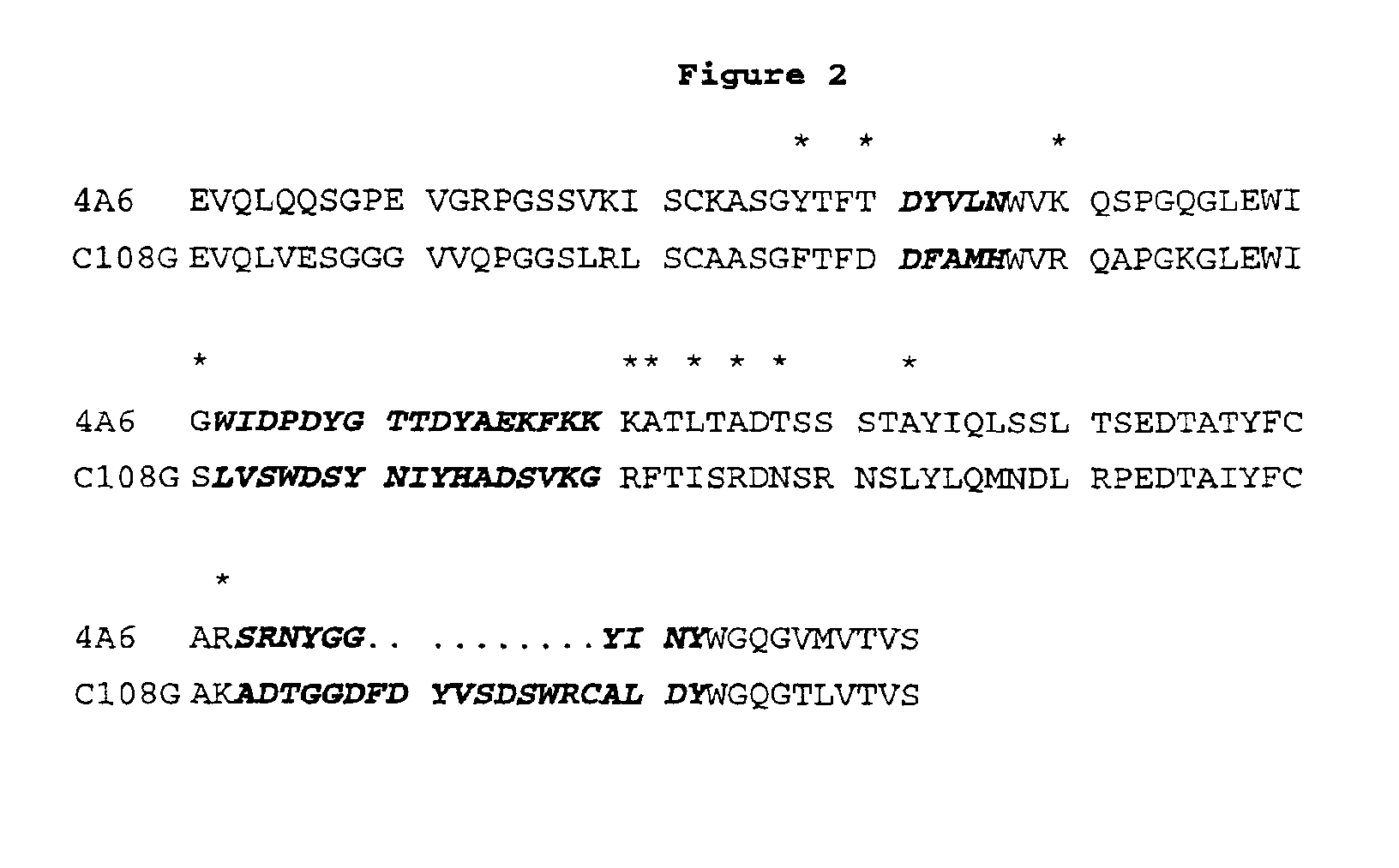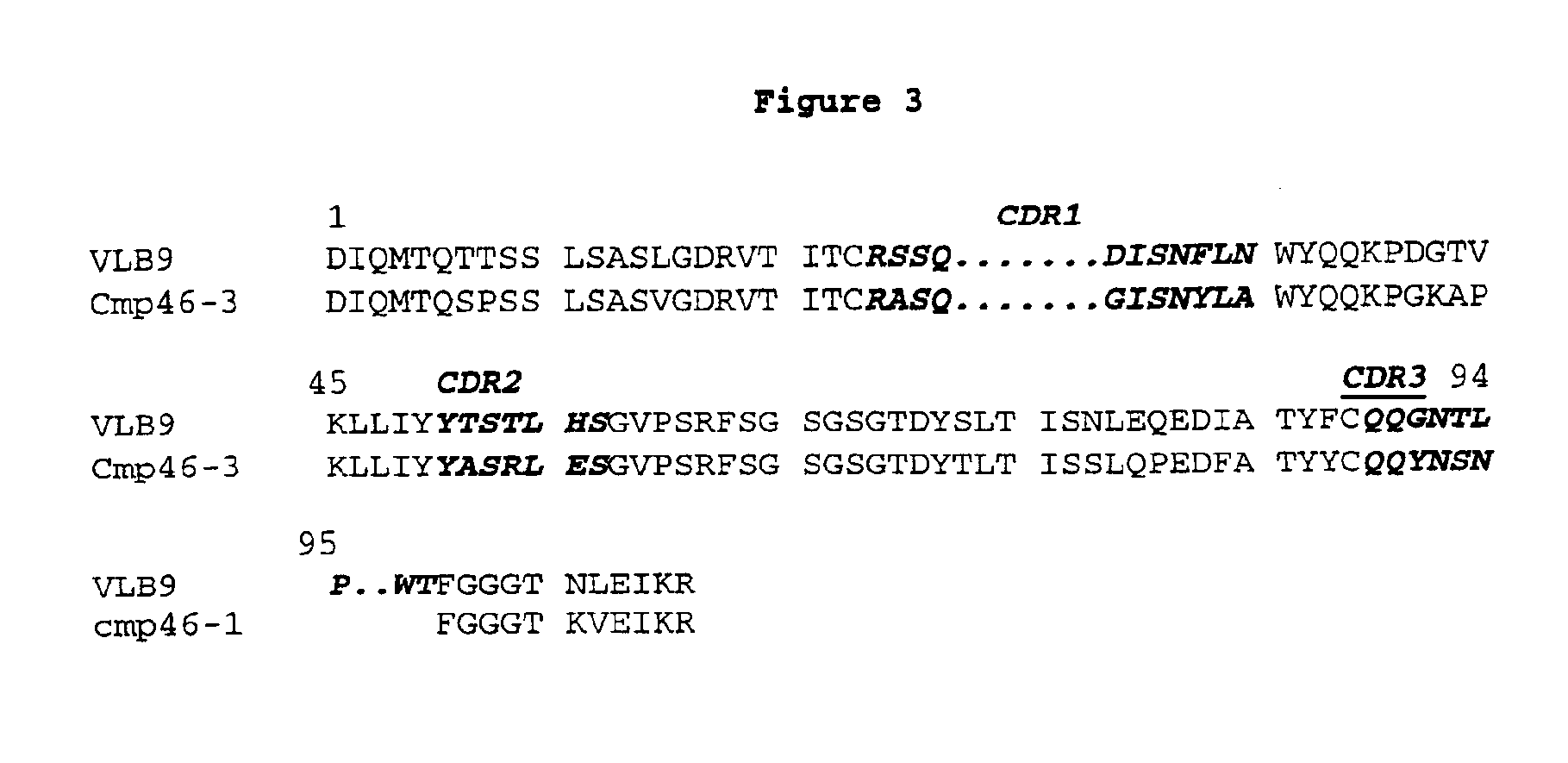Monoclonal antibodies with reduced immunogenicity
a monoclonal antibody and immunogenicity technology, applied in the field of monoclonal antibodies, can solve the problems of limited cdr grafting methods, limited human acceptor frameworks, and limited degree of match between non-human donors
- Summary
- Abstract
- Description
- Claims
- Application Information
AI Technical Summary
Problems solved by technology
Method used
Image
Examples
example 1
Random cDNA Cloning and Sequence Analysis of Chimpanzee VH Regions
[0051]Five ml of peripheral blood was collected and pooled from three chimpanzees (Pan troglodytes) and peripheral blood mononuclear cells were isolated by standard density centrifugation methods. These cells, which include antibody producing lymphocytes, were dissolved in TRIzol reagent (GIBCO, Gaithersburg, Md., USA) and total RNA was recovered from this material by solvent extraction and precipitation according to the manufacturer's specifications.
[0052]Chimpanzee heavy chain V regions were cloned from the total RNA using Marathon RACE methodology (Clontech, Palo Alto, Calif., USA) following exactly the manufacturer's protocol using 3′ Cg1 gene specific primers. After RACE PCR amplification, DNA bands of the expected size were excised from agarose gels, the DNA was purified and cloned into a plasmid vector. Although this cDNA library contains many distinct heavy chain V region clones, nine were selected randomly fo...
example 2
Random cDNA Cloning and Sequence Analysis of Chimpanzee Vκ Regions
[0057]Chimpanzee light chain Vκ regions were cloned from the total RNA using Marathon RACE methodology (Clontech, Palo Alto, Calif., USA) following exactly the manufacturer's protocol and Cκ 3′ gene specific primers. After RACE PCR amplification, DNA bands of the expected size were excised from agarose gels, the DNA was purified and cloned into a plasmid vector. Although this cDNA library contains many distinct light chain Vκ region clones, nine were selected randomly for sequence analysis. Complete nucleic acid sequences and predicted protein sequences of the chimpanzee Vκ cDNA clones 46-1, 46-3, 46-4, 46-5, 46-6, 46-7, 46-8, 46-11 and 46-14 are shown in SEQ ID NOs: 19, 20, 21, 22, 23, 24, 25, 26 and 27, respectively. The amino acid sequences of the region from the first amino acid of the mature Vκ region to the second conserved cysteine residue at position 88, adjacent to CDR III of these clones, namely CPVκ46-1, CP...
example 3
Random cDNA Cloning and Sequence Analysis of Cynomolgus VH Regions
[0061]Splenic RNA was recovered from a single donor cynomolgus monkey (Macaca cynomolgus) by means of standard laboratory practice. Cynomolgus heavy chain V regions were cloned from the total RNA using Marathon RACE methodology (Clontech, Palo Alto, Calif., USA) following exactly the manufacturer's protocol using 3′ Cg1 gene specific primers. After RACE PCR amplification, DNA bands of the expected size were excised from agarose gels, the DNA was purified and cloned into a plasmid vector. Although this cDNA library contains many distinct heavy V region clones, eight were selected randomly for sequence analysis. Complete nucleic acid sequences and predicted protein sequences of the Cynomolgus VH cDNA clones 2-1, 2-3, 2-4, 2-5, 2-6, 2-7, 2-8 and 2-10 are shown in SEQ ID NOs: 37, 38, 39, 40, 41, 42, 43 and 44, respectively. The amino acid sequences of the region from the first amino acid of the mature VH region to the sec...
PUM
| Property | Measurement | Unit |
|---|---|---|
| flow rate | aaaaa | aaaaa |
| temperature | aaaaa | aaaaa |
| van der Waals radius | aaaaa | aaaaa |
Abstract
Description
Claims
Application Information
 Login to View More
Login to View More - Generate Ideas
- Intellectual Property
- Life Sciences
- Materials
- Tech Scout
- Unparalleled Data Quality
- Higher Quality Content
- 60% Fewer Hallucinations
Browse by: Latest US Patents, China's latest patents, Technical Efficacy Thesaurus, Application Domain, Technology Topic, Popular Technical Reports.
© 2025 PatSnap. All rights reserved.Legal|Privacy policy|Modern Slavery Act Transparency Statement|Sitemap|About US| Contact US: help@patsnap.com



